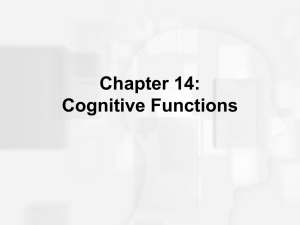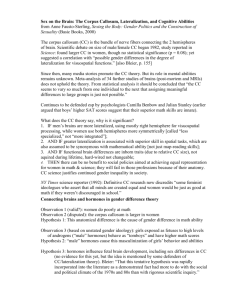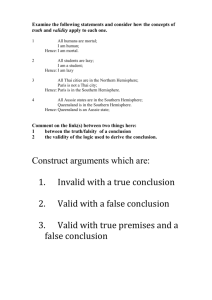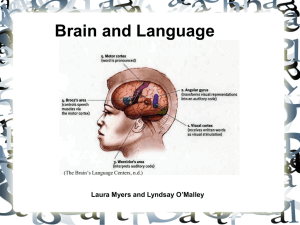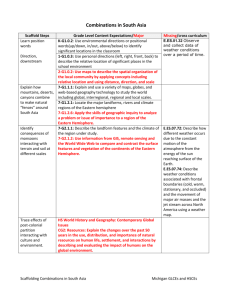Chapter 14: Cognitive Functions • Lateralization of Function
advertisement
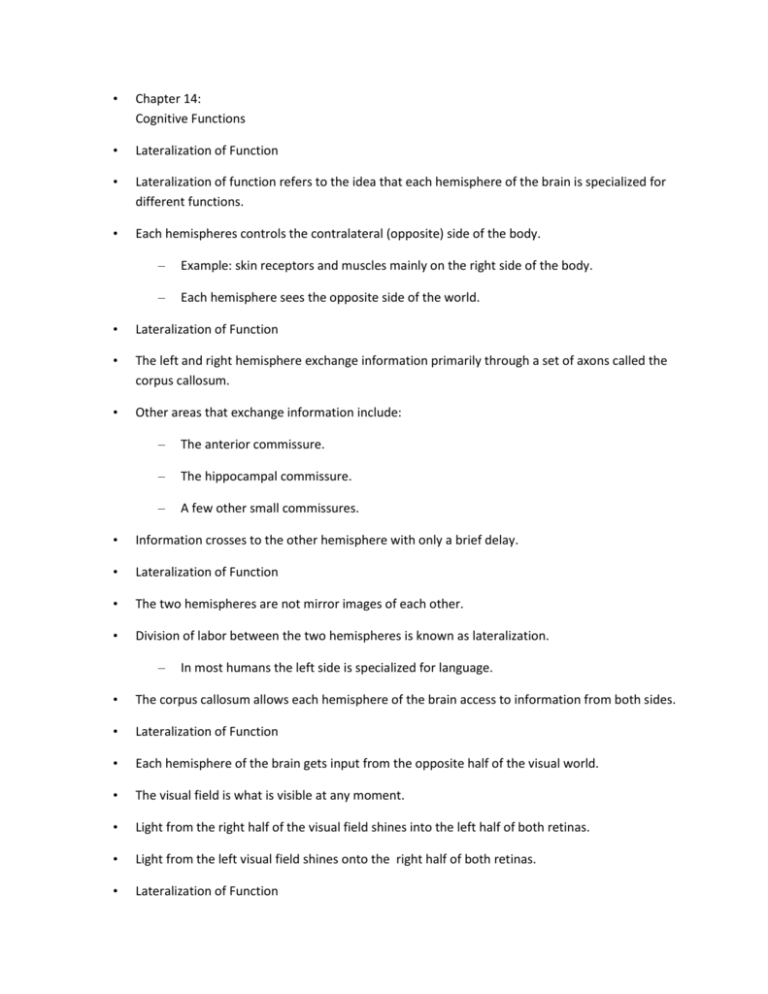
• Chapter 14: Cognitive Functions • Lateralization of Function • Lateralization of function refers to the idea that each hemisphere of the brain is specialized for different functions. • Each hemispheres controls the contralateral (opposite) side of the body. – Example: skin receptors and muscles mainly on the right side of the body. – Each hemisphere sees the opposite side of the world. • Lateralization of Function • The left and right hemisphere exchange information primarily through a set of axons called the corpus callosum. • Other areas that exchange information include: – The anterior commissure. – The hippocampal commissure. – A few other small commissures. • Information crosses to the other hemisphere with only a brief delay. • Lateralization of Function • The two hemispheres are not mirror images of each other. • Division of labor between the two hemispheres is known as lateralization. – In most humans the left side is specialized for language. • The corpus callosum allows each hemisphere of the brain access to information from both sides. • Lateralization of Function • Each hemisphere of the brain gets input from the opposite half of the visual world. • The visual field is what is visible at any moment. • Light from the right half of the visual field shines into the left half of both retinas. • Light from the left visual field shines onto the right half of both retinas. • Lateralization of Function • The left half of each retina connects to the left hemisphere. • The right half of each retina connects to the right hemisphere. • Half of the axons from each eye cross to the opposite side of the brain at the optic chiasm. • The auditory system is arranged differently in that each ear sends the information to both sides of the brain. • Lateralization of Function • Damage to the corpus callosum interferes with the exchange of information between hemispheres. • Epilepsy is a condition characterized by repeated episodes of excessive synchronized neural activity. – Mainly due to decreased release of the inhibitory neurotransmitter GABA. • Physicians once cut the corpus callosum to prevent the seizure from spreading to the opposite side of the body. • Lateralization of Function • People who have undergone surgery to the corpus callosum are referred to as split-brain people. • Spit brain people maintain normal intellect and motivation but they tend to: – Use hands independently in a way others cannot. – Respond differently to stimuli presented to only one side of the body. • Lateralization of Function • Sperry (1974) revealed subtle behavioral differences for spilt brain people. • Because the left side of the brain is dominant for language in most people, most split brain people: – Have difficulty naming objects briefly viewed in the left visual field. • A small amount of information can still be transferred via several smaller commissures. • Lateralization of Function • Immediately after surgery, each hemisphere can only quickly and accurately respond to information that reaches it directly. – Smaller commissures allow a slower response. • The brain later learns use the smaller connections: • Difficulty integrating information between both remains. • Lateralization of Function • Right hemisphere is better at perceiving emotions. • Damage to parts of the right hemisphere causes difficulty perceiving other’s emotions, failure to understand humor and sarcasm, and a monotone voice. • Left hemisphere damage increases ability to accurately judge emotion. – Associated with decreased interference from the left hemispheres. • Lateralization of Function • The right hemisphere is also better at comprehending spatial relationships. • In general, the left hemisphere seems to focus more on visual details, and the right hemisphere focuses more on visual patterns. • Lateralization of Function • Some anatomical differences exist between the hemispheres of the brain. • The planum temporale is an area of the temporal cortex that is larger in the left hemisphere in 65% of people. – Difference are slightly greater for people who are strongly right handed. • MRI studies indicate that the a big difference in the ratio of left to right planum temporale is related to increased language performance. • Lateralization of Function • Damage to left hemisphere often results in language deficiencies. • Left side seems to be specialized for language from the very beginning in most people. • The corpus callosum matures gradually through the first 5 to 10 years. – • Thus, young children have difficulty comparing information from the left and right hand. Lateralization of Function • Being born with a condition where the corpus callosum does not completely develop results in extra development of the following: – Anterior commissure - connects the anterior parts of the cerebral cortex. – Hippocampal commissure - connects the left and right hippocampus. • Allows performance on some tasks that differs from split-brain people. • Lateralization of Function • The left hemisphere is dominant for speech in 95% of right-handed people. • Most left-handers have left-hemisphere or mixed-dominance for speech. – Few people have strong right hemisphere dominance. • Lateralization of Function • Recovery of language after damage to the brain varies. • Age affects extent of recovery. – Brain is more plastic at an early age. • Right hemisphere reorganizes to serve some of the left-hemisphere function. • Lateralization of Function • Rasmussen’s encephalopathy is a rare condition in which the immune system initially attacks the glia and then the neurons of one hemispheres of the brain. – Usually begins in childhood or adolescence. • Surgeons eventually remove or disconnect the side of the damaged brain. • Language recovers slowly but substantially. – Slow deterioration allows the other side of the brain to compensate and reorganize. • Lateralization of Function • Language recovery after brain damage is also influenced by how language was initially lateralized for the given person. • Individuals with partial representation of language in both hemispheres recover better than those with language dominance in one hemisphere. • Evolution and Physiology of Language • Human language is a complex form of communication. • Compared to other species, human language has high productivity/generativity. – Productivity/generativity - the ability to produce new signals to represent new ideas. • Evolution and Physiology of Language • Human language is most likely a modification of a behavior also found in other species. • Chimpanzees use language but it differs from humans: – Seldom use symbols in new original combinations. – Use of symbols lacks productivity. – Use of symbols is primarily used to request and not describe. – Production of requests is better than understanding other’s requests. • Evolution and Physiology of Language • Bonobos or pygmy chimpanzees show an increased comprehension of human language: – Understand more than they can produce. – Use symbols and names to describe objects. – Request items not seen. – Use symbols to describe past events. – Make original, creative requests. • Lateralization of Function • Non-primates also display some aspects of spoken language. • Elephants imitate sounds they hear, including the vocalizations of other elephants. • Dolphins respond to gestures and sounds. • The African gray parrot show a great ability for imitating sounds and also using sounds meaningfully. – • Example: Alex the gray parrot. Evolution and Physiology of Language Studies of nonhuman language abilities: • Give insights to how best to teach language to those who do not learn it easily. – • Examples: Brain damaged people or children with autism. Illustrate the ambiguity of our concept of language. – Allows for more precise definition. • Evolution and Physiology of Language • Two categories of theories attempt to explain the human ability to learn language more easily than other species. – “Language evolved as a by-product of overall brain development.” – “Language evolved as an extra part of the brain.” • Evolution and Physiology of Language • Problems associated with the “language as a by-product of increased intelligence” theory: – People with a full-size brain and normal overall intelligence can show severe language deficits. – People with impaired intelligence can have normal language skills. • Williams syndrome characterized by metal retardation but skillful use of language. • Evolution and Physiology of Language • Evidence suggesting language evolved as an extra brain module specialization includes: – Language acquisition device is a built in mechanism for acquiring language. • – Evidence comes from the ease at which most children develop language. Chomsky (1980) further suggests the poverty of stimulus argument: children do not hear many examples of some of the grammatical structures they acquire. • Evolution and Physiology of Language • Most researchers agree that humans have a specially evolved “something” that enables them to learn language easily. – Certain brain areas are indeed necessary for language. – But same areas are also necessary for other tasks (memory and music perception). • Exactly how humans evolved language is unknown but is perhaps due to the pressure for social interaction. • Evolution and Physiology of Language • Research suggests a critical period exists for the learning of language (Lenneberg). • Learning of a second language differs as a function of age: – • Children are better at learning pronunciation and unfamiliar aspects of grammar. No sharp cutoff exist for second language learning. – Adults learn a second-language vocabulary better. • Evolution and Physiology of Language • Rare cases of children not exposed to language indicates limited ability to learn language later. • Deaf children unable to learn spoken language and not given the opportunity to learn sign language while young reveals: – Little development of skill at any language later. – Early exposure to some language increases ability to learn another language later. • Evolution and Physiology of Language • Most knowledge of brain mechanisms of language come from the study of people with brain damage: – Broca’s area is a part of the frontal lobe of the left cerebral cortex near the motor cortex. • – Damage results in some language disability. Aphasia refers to a condition in which there is severe language impairment. • Evolution and Physiology of Language • Broca’s aphasia/nonfluent aphasia refers to serious impairment in language production, usually due to brain damage. • Omission of most pronouns, prepositions, conjunctions, auxiliary verbs, tense and number endings during speech production. • People with Broca's aphasia have trouble understanding the same kinds of words they omit (prepositions and conjunctions). • Evolution and Physiology of Language • Broca’s aphasia is usually accompanied by comprehension deficits when: – The sentence meaning depends on prepositions, word endings or unusual word order. – Sentence structure is complicated. • Broca’s area thus seems to be critical for the understanding of some, but not all, aspects of grammar. • Evolution and Physiology of Language • Wernicke’s area is an area of the brain located near the auditory part of the cerebral cortex. • Wernicke’s aphasia is characterized by the impaired ability to remember the names of objects and also impaired language comprehension. – Sometimes called “fluent aphasia” because the person can still speak smoothly. • Recognition of items is often not impaired; ability to find word is impaired. • Evolution and Physiology of Language • Typical characteristics of Wernicke’s aphasia include: – Articulate speech / fluent speech except with pauses to find the right word. – Difficulty finding the right word - anomia refers to the difficulty recalling the name of objects. – Poor language comprehension - difficulty understanding spoken and written speech (especially nouns and verbs). • Evolution and Physiology of Language • Dyslexia is a specific impairment of reading in a person with adequate vision and adequate skills in other academic areas. – More common in boys. – Research suggests a genetic influence. • Evolution and Physiology of Language • In some cases, dyslexia is associated with mild abnormality in the structures of various brain areas. – More likely to have a bilateral symmetrical cerebral cortex. – Language–related areas in the right hemisphere are larger in some. – Weak connections exist among other areas. • Evolution and Physiology of Language • Different kinds of dyslexics have different reading problems. • “Dysphonic dyslexics” have trouble sounding out words. – • Attempt to remember them as a whole. “Dyseidetic dyslexics” fail to recognize a word as a whole. – Read slowly and have particular trouble with irregularly spelled words. • Evolution and Physiology of Language • Most severe cases of “dyseidetic dyslexia” result from brain damage that restricts the field of vision. • Characterized by the following: – only seeing one letter a time. – short eye movements. – very slow reading. – difficulty with long words. • Evolution and Physiology of Language • One hypothesis to explain dyslexia emphasizes a hearing impairment rather than visual impairment. – Less than normal response to speech sounds in the brain. – Lack of ability to pay close attention to sounds. • Evolution and Physiology of Language • Another hypothesis to explain dyslexia is connecting vision to sound. • Brain scans indicate that reading strongly activates areas of the left temporal and parietal cortex for most people. – • Areas are associated with connecting visual and auditory information. Only weakly activated for people with dyslexia. • Evolution and Physiology of Language • A final hypothesis relates dyslexia to differences in attention. • Reading requires the shifting of attention. • People with dyslexia do not shift their attention in the same way. • Effective treatment may be for dyslexics to focus on one word at a time. • Attention • Attention is a multi-dimensional process and related to consciousness. • Attention relates to increased brain activity in the areas responsive to a stimulus. • Stimuli destined to become conscious or unconscious produce about the same brain activity in the first 200-250 milliseconds. • In the next few milliseconds, the brain enhances activity for stimuli that become conscious. • Attention • Enhancement of activity can be due to intensity of the stimulus, similarity to past important stimuli, or other features of the stimulus itself. • Enhancement of activity can also be due to shifting of attention. • Research suggests that attention pertains more to the enhancing of relevant activity than inhibiting irrelevant activity. • Attention • “Inattention” or “neglect” is the opposite of attention. • Spatial neglect is a tendency to ignore the left side of the body and its surroundings or the left side of objects. – Often associated with damage to the right hemisphere of the brain. • Attention • Exact location of the damage to the right hemisphere can affect the details of what the person neglects. – Damage to the inferior part of the right parietal cortex leads to the neglect of everything to the left of their own body. – Damage to the superior temporal cortex neglect the left side of objects, regardless of location. • Attention • Problems of neglect are associated with attention and not sensation. • Someone with neglect can see an entire letter enough to say what it is. • The same person ignores the left half when asked to cross out all the letters that compose a word. • Attention • Several procedures can increase attention to the neglected side: – telling the person to pay attention to the left side. – telling the person to look left while feeling an object with the left hand or hearing a sound from the left side. • A touch stimulus briefly increases attention to one side of the body or the other. • Crossing of the hands in front of the body also decreases neglect to the left side. • Attention • Many patients with spatial neglect also have deficits with spatial working memory and with shifting attention, even when location is irrelevant. • Thus, problems associated with neglect extend to many aspect of attention rather than simply the left-right dimension. • Attention • Attention-Deficit Hyperactivity Disorder (ADHD) is characterized by the following: – Attention deficits (distractibility). – Hyperactivity (fidgetiness). – Impulsiveness. – Mood swings. – Short temper. – High sensitivity to stress. – Impaired ability to make and follow plans. • Attention • ADHD affects social behavior and school performance. • Some have occupational problems and antisocial behaviors in adulthood. • Estimates range from 3%-10% of children • Twice or three times as likely in males. • Research is complicated by the ability to make reliable diagnoses. • Attention • Three example of tasks which people with ADHD differ: – “The choice delay task” - more likely than others to choose a smaller but quicker reward (impulsiveness). – “The stop signal task” - difficulty inhibiting behaviors. – “The attentional blink task” - indicates trouble controlling attention and difficulty shifting it when needed. • Attention • Twin studies suggest fairly high heritability (Thapar et al., 2003). – Several genes have been identified which influence performance on tests of attention. • ADHD probably depends on multiple genes as well as environmental influences. • Probability of ADHD is elevated among children of women who smoked cigarettes during pregnancy. • Attention • Structural brain differences include a smaller than average prefrontal cortex and cerebellum. – • Cerebellar dysfunction is known to be associated with difficulty switching attention. Structural differences in the brain are small and inconsistent between cases. – Brain scans do not provide reliable results for diagnoses. • Attention • The most common treatment for ADHD is stimulant drugs or amphetamines. – Example: methylphenidate/Ritalin. • Stimulant drugs increase attentiveness, improve school performance and social relationships, and decrease impulsiveness. • Also improve scores on laboratory tests, such as the “stop signal task”. • Justifying the benefits derived from taking the drugs is a complex and controversial issue. • Attention • Amphetamines and methylphenidate increase the availability of dopamine to the postsynaptic receptors. • Maximum benefit occurs 1 hour after ingestion and benefits last for a few hours. • Several studies have found that stimulant drugs enhance certain aspects of learning and attention for all people, not just those with ADHD. • Attention • Behavioral techniques are available as supplements or substitutes for stimulant drugs: – Reduce distractions. – Use lists, calendars, and other organizational techniques. – Practice strategies to pace yourself. – Learn to relax; tension and stress can magnify attention deficits.

